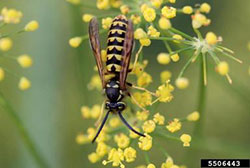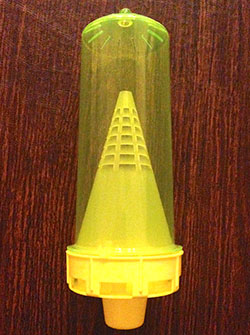Craig Seymour
Colorado State University Extension Master Gardener in Larimer County
February 22, 2015

The western yellowjacket wasp is deserving of its annoying reputation around backyard cookouts and picnic outings each summer. Although most victims of an insect sting blame them on bees, the western yellowjacket can claim over 90% of all “bee stings” in Colorado. followed by the European paper wasp. That leaves only a small percentage of stings actually credited to the lovable bees.
For general identification the honeybee, bumble bee and leaf cutter bees are hairy, stout bodied with muted colors of black, brown, yellow, orange and gray and usually covered in pollen. Hornets, yellowjackets and paper wasps are not hairy and have elongated bodies and bold coloring of black, yellow, orange and creamy white. Bees are beneficial pollinators. Wasps are beneficial insect predators. Bees and wasps are usually non-aggressive unless trapped or their nest is disturbed.
The western and European yellowjacket female wasps are the two notorious villains of the bees and wasps with stingers (males do not have stingers). The European yellowjacket, a relative newcomer to Colorado, is a nuisance wasp primarily because it likes to build its open paper nest in small cavities such as down spouts, grills, playground equipment, open metal tubes and similar places close to human activity. Therefore their nests are easily disturbed before we are aware of their presence, which may result in a sting.

The paper nests that are found can be controlled with any good wasp spray, usually spraying in late evening or early morning when all the wasps are on the nest and fairly inactive. If the nest is a safe distance from normal activities the nest can be left to develop, since the European yellowjacket is a beneficial insect predator. Another species of paper wasp will build a similar open paper nest but they are usually found attached to an overhang such as a deck or eve and should not be disturbed unless they are too close to human activities.
On the other hand, the deplorable western yellowjacket wasp is a scavenger of protein: dead insects, carrion, garbage, meat, sweet foods and sugary drinks. It will aggressively defend its food source. The western yellowjacket is an annual social wasp in which an overwintering fertilized queen wasp will locate a in-ground cavity in the spring, build a new nest, lay eggs and feed the first larvae until a colony of the queen (fertile female), worker wasps (infertile females) and drones (fertile males) is established.
It is that life cycle and the western yellowjackets attraction to the chemical hepytl butyrate that makes it susceptible to early control with a wasp trap. No other bees or wasps are attracted to a baited wasp trap. The western yellowjacket trap should be properly installed in late April when the queen is foraging for nesting material and protein, usually in late April and throughout May. Each western yellowjacket trapped in early spring is a queen wasp and her capture will eliminate one colony, which can produce 200 plus wasps by September.
In June, the queen stays in the colony, but the worker wasps can continue to be caught in a properly maintained trap. It may seem futile but a trap count can be an indication of the areas western yellowjacket population and give the trapper bragging rights for his effort. If the well-concealed entrance of a ground nest could be located, a repeated nighttime application of an insecticide, such as permethrin, can eventually eliminate a colony. It will take persistent applications especially late in the season.
It is important to properly identify the nesting insect because the bumblebee also has an in-ground nest that should not be destroyed regardless of its location. Even if a western yellowjacket colony is eliminated the worker wasps can travel up to 1,000 yards from their colonies in search of protein making the task of complete control improbable.
More information about bees and wasps can be found at ext.colostate.edu/pubs/insect/05525, Nuisance Wasps and Bees by W.S. Cranshaw. Colorado State University Extension supports the Colorado Master Gardener program and the information provided is a result of scientific research.
So the question becomes, “Do I live with the western yellowjacket wasp or wage war on the despicable pest?” If peaceful compliance is your choice then eliminate its food and water sources, be outdoors without food or drinks, dine out in early morning or late evenings (wasps vs. mosquitos), have a screened porch or tent for separation or retreat indoors for the summer and hope for nice late fall days to enjoy an outdoor meal.
As gardeners and consumers have become more interested in enjoying locally produced food and living within the ecological balance of nature it is important to recognize the value of bees and wasps. They are very entertaining flower pollinators and insect predators. Therefore the goal should be to eliminate only the pests that are an imminent threat and leave the rest to observe and enjoy as they go about their given tasks in nature.
Western Yellowjacket Wasp photo by Whitney Cranshaw. Yellowjacket trap photo by Craig Seymour.
The author has received training through Colorado State University Extension’s Master Gardener program and is a Master Gardener volunteer for Larimer County.
——————-
Larimer County is a county-based outreach of Colorado State University Extension providing information you can trust to deal with current issues in agriculture, horticulture, nutrition and food safety, 4-H, small acreage, money management and parenting. For more information about CSU Extension in Larimer County, call (970) 498-6000 or visit www.larimer.org/ext
——————-
Looking for additional gardening information? Check out the CSU Extension Horticulture Agent blog at www.csuhort.blogspot.com for timely updates about gardening around the state.
——————-
Visit PlantTalk Colorado ™ for fast answers to your gardening questions! www.planttalk.org PlantTalk is a cooperation between Colorado State University Extension, GreenCo and Denver Botanic Gardens.





